30 Years continued 2
Remembering three decades of marches, activism, and celebration.
By David Fagan and Skip Teauxmelou
Photos by Dalton DeHart, Blase DiStefano, and Fred Paez
Previous • Next
Page 1 • 2 • 3
Timeline • Sources
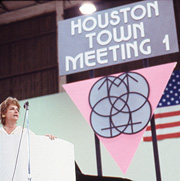
TOWN MEETING I
The following year, in June of 1978, Houston saw its first official Gay Pride Week coordinated by the Houston GLPC with a full schedule of political and social events. The main event was Town Meeting I, held on June 25 in the AstroArena (a hall adjacent to the Astrodome in what is now Reliant Park). The meeting came at the end of National Gay Pride Week and was chaired by Ginny Apuzzo of the National Gay Task Force. Keynote speaker was former Texas State Representative, gubernatorial candidate, and later vice-presidential candidate Sissy Farenthold, whose words spoke directly to the meeting’s resolutions regarding civil rights, health, and safety for the gay community: “We are none of us free unless we all are free. We cannot open the door to some minorities while denying access to others.”
More than 4,500 people attended Town Meeting I, which, according to the Houston Chronicle, was “the first such politically oriented homosexual meeting in the United States.” The stated purpose was to address the concerns of Houston’s gay community as outlined in 13 propositions voted upon by those attending. The resolutions addressed job security, police action against gays, health care, and repeal of the Texas sodomy statute. The resolutions, as passed by Town Meeting I, resulted in the creation of many organizations, including the Montrose Counseling Center, the Montrose Activity Center, the Gay and Lesbian Switchboard, the Hispanic Caucus, and the Montrose Sports Association.
PRIDE PARADE BECOMES ‘OFFICIAL’
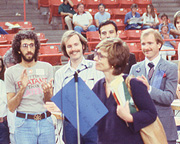
iding the momentum of Town Meeting I, and the organizational structures that grew from it, the Houston GLPC supported the organization of Houston’s first official Pride parade, coordinated by the Parade Committee under the direction of Larry Bagneris. In a move that became the cornerstone of subsequent parade organization, Larry held open community meetings to plan the parade, and from these came the concept of Grand Marshal and the development of parade themes and merchandise.
Held on Sunday, July 1, 1979, the first parade reflected the solidarity of Houston’s emerging gay community in its theme, United We Stand. In addition to floats, many of them simple flatbed trucks or pickups festooned by the sponsoring organization, several of the gay bars also sponsored entries. The Parade Committee chose as the first Grand Marshal Thelma Hansel, aka “Disco Grandma” as she was known in the community (because of her love of the evening drag shows at the Old Plantation, which she often attended with her son) for being openly proud and accepting of her gay son and his lover.
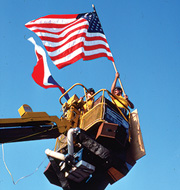
According to the Houston Voice, the crowd lining Westheimer for the first parade was estimated between 10,000 and 12,000. The event was covered by Houston newspapers and television stations. A rally followed at Spotts Park, where 5,000 people enjoyed music, speeches, dancing, and fireworks. Among the speakers were Midge Costanza, former aide to President Jimmy Carter; Harry Britt, the San Francisco supervisor who replaced slain supervisor Harvey Milk; and Jean O’Leary, co-executive director of the National Gay Task Force.
By 1980 Houston’s Pride Week had grown to a 10-day celebration. Then, in 1997, parade organizers decided to foil Houston’s summer heat and founded the nation’s first night-time parade. The format for the main body of today’s Pride Week, with a light-up-the-night parade and daily events—some serious, some frivolous, and others downright saucy—had taken form.
Each parade has reflected that year’s political atmosphere as it affected Houston’s GLBT community. And more than once, dramatic events unfolded in the days immediately preceding or following the parade. In 1980, Mary’s float, depicting a police officer delivering a beating, so perfectly mirrored that year’s tensions that it was awarded the Grand Prize. 1988’s Honorary Grand Marshals, both of whom did not appear and could not have appeared in the parade, came from that year’s headlines: slain San Francisco public official Harvey Milk and severely disabled accident survivor Sharon Kowalski, whose lesbian lover began a long legal battle to gain custody of Sharon.
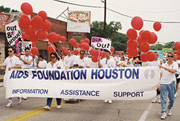
Just prior to 1984’s parade, two buses arrived at Mary’s on the corner of Westheimer and Waugh. On board were 58 Ku Klux Klan members from Pasadena, Texas. Under the watchful eye of 600 riot-equipped HPD officers, two helicopters, and numerous police cruisers, the Klan’s 16-minute march in Montrose—at a cost to taxpayers of $80,000—drew an estimated 2,000 spectators, mostly heterosexual concerned Montrose residents. The gay community, encouraged by the GLPC to stay away, largely ignored the event.
That same year, a struggle that was to last 13 years was taking shape in City Council chambers. An overflow crowd, including the KKK and various religious groups, with signs such as “Don’t turn Houston into Sodom,” continuously interrupted the 90-minute meeting. Despite the ensuing confusion, Counsel passed amendments to existing ordinances, which would extend nondiscrimination protection to gays and lesbians. Although the amendments passed 8–7 with Mayor Kathy Whitmire casting the tie-breaking vote, and 9–6 with Councilman Jim Greenwood adding his support, their passage met swift and well-funded opposition. Within a month the necessary signatures were obtained to force City Council to either rescind the ordinance or call a referendum. The City Council, refusing to reverse its action, set a special election for January of the following year. As Councilwoman Eleanor Tinsley said to the Houston Chronicle , “Gays are discriminated against now as Jews, blacks, and women have been in the past . . . it’s a civil rights issue, not a moral issue, except that it’s immoral to discriminate.”
BACKLASH AT THE POLLS AND IN THE STREETS
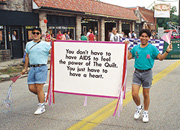
General uneasiness increased in direct proportion to the increase of AIDS and the media coverage of what had been termed “the Gay plague,” and the backlash to the City Council’s amendments to add gays and lesbians to the city’s nondiscrimination ordinances played on the general hysteria.
The months that led up to the referendum in January 1985 saw unprecedented public homophobia. Former Mayor Louie Welch, chairman of the Houston Chamber of Commerce, led the opposition in pushing the referendum with support from the Moral Majority, the Committee for Public Awareness (Councilman John Goodner, chair), Campaign for Houston (Stephen Hotze, chair), the Ku Klux Klan, the Harris County Republican Party, as well as members of Houston’s black religious community. Goodner said his Committee for Public Awareness was prepared to spend up to $400,000 (after the election, the committee reported to the city secretary that it had spent $101,460).
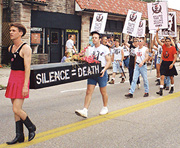
Support for the ordinances was led by Citizens for a United Houston (Diane Berg, chair) with the backing of the Houston League of Women, the American-Jewish Committee, the Houston Area Women’s Center, the American Civil Liberties Union, and several area churches. Berg’s Citizens for a United Houston spent “a bit less” than their opponents, and the city budgeted $350,000 to hold the referendum.
Tension and rhetoric escalated as the January vote drew near, with GLPC President Sue Lovell revealing that the caucus had received death threats, which were also directed at Whitmire and the council members who had supported the ordinance amendments.
When the amendments were defeated at the January 19, 1985, referendum by a whopping 82 percent, Louie Welch
announced his mayoral aspirations, entering the race with a “Straight Slate” of candidates for City Council, who sought to unseat council members who had voted for the gay-lesbian amendments to the city’s nondiscrimination ordinances. The heated campaign rhetoric drew national attention.
(Story continued…)
Previous • Next
Page 1 • 2 • 3
Timeline • Sources










